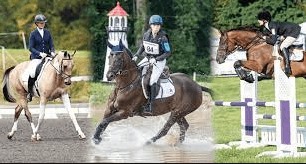What Are The Main Phases In Eventing?

Eventing, also known as horse trials or three-day eventing, is an equestrian sport that combines three different disciplines: dressage, cross-country, and show jumping. Each phase tests the rider’s and horse’s skills in various ways, creating a comprehensive assessment of their abilities.
In this article, we will explore the main phases in eventing and delve into the unique challenges they present.
The first phase of eventing is dressage, which serves as the foundation for success in this sport. Dressage showcases the horse’s obedience, suppleness, and precision of movement through a series of predetermined movements. The rider must demonstrate their ability to communicate effectively with their equine partner while maintaining proper position and control. Dressage requires a deep understanding of biomechanics and balance to execute movements such as transitions, lateral work, and collection accurately. It sets the stage for a harmonious partnership between horse and rider by establishing discipline and control before progressing to more challenging phases.
As we delve into the world of eventing further, it becomes evident that dressage lays the groundwork for achieving success in subsequent phases.
Dressage: The Foundation for Success in Eventing
Dressage serves as the essential groundwork for achieving success in eventing by providing a solid foundation for the horse’s training and overall performance.
Dressage techniques, including the correct rider position, play a crucial role in developing a harmonious partnership between horse and rider.
The meticulous attention to detail required in dressage helps improve the horse’s balance, suppleness, and obedience, which are all vital components for success in eventing.
Through precise movements and exercises, dressage enhances the horse’s ability to respond to subtle aids from the rider, resulting in improved communication and control.
Additionally, dressage fosters physical strength and flexibility in both horse and rider, enabling them to execute complex maneuvers with ease.
By establishing a strong base of skills through dressage training, eventing competitors can confidently progress through subsequent phases of competition with greater precision and grace.
Cross-Country: Testing Skills, Agility, and Endurance
Cross-country, the second phase in eventing, requires riders to navigate challenging terrain and obstacles.
This phase tests their skills, agility, and endurance as they maneuver through natural elements such as water crossings, ditches, banks, and solid fences.
Riders must maintain a steady pace throughout the course while successfully clearing jumps that vary in height and difficulty.
Time is also a crucial factor in cross-country, as penalties are incurred for going over the optimum time or making mistakes or faults along the way.
Navigate Challenging Terrain and Obstacles
To successfully navigate challenging terrain and obstacles, event riders must demonstrate exceptional skill and precision in their approach. The combination of difficult terrain and various obstacles requires riders to have a deep understanding of their horse’s capabilities and the ability to make split-second decisions.
Riders must carefully assess the terrain, taking into account factors such as steep inclines, uneven ground, and slippery surfaces. They must also anticipate the challenges posed by obstacles such as fences, ditches, water crossings, and combinations.
During the cross-country phase of eventing, riders must navigate through these challenging terrains and obstacles with finesse and agility. They need to maintain balance and control while adjusting their riding techniques based on the specific demands of each obstacle or terrain feature.
This requires a high level of physical fitness from both horse and rider as they maneuver through the course with speed and accuracy. Overall, successful navigation of challenging terrain and obstacles is crucial in eventing as it not only tests the skills of riders but also ensures the safety of both horse and rider throughout the competition.
- Steep inclines: Riders must carefully manage their horse’s pace while ascending or descending steep slopes to maintain balance.
- Uneven ground: Negotiating uneven ground requires riders to constantly adjust their position in order to keep their horse balanced.
- Slippery surfaces: Riding on slippery surfaces demands careful weight distribution from both horse and rider to prevent falls or accidents during turns or jumps.
Maintain a Steady Pace and Clear Jumps
Maintaining a consistent rhythm and executing precise jumps are essential elements of navigating an eventing course.
Staying focused and maintaining a steady pace allows the rider to navigate the various obstacles with ease. This requires a combination of rhythm and balance, where the horse maintains a consistent speed while also remaining balanced throughout each jump.
Effective communication between the rider and horse is crucial in achieving this, as the rider must provide clear cues and signals to guide the horse through each jump.
Mental preparation is also key, as it helps the rider remain calm and focused during the course, allowing them to make quick decisions and adjustments when necessary.
By incorporating these aspects into their riding technique, competitors can successfully maintain a steady pace and clear jumps throughout an eventing course.
Time and Penalties for Mistakes or Faults
Penalties are incurred for mistakes or faults made during the course, and these penalties can have a significant impact on a competitor’s overall performance.
In eventing, time management plays a crucial role in achieving success. Competitors must complete each phase within a specified time limit, and exceeding this limit results in time penalties. Therefore, maintaining an efficient pace while navigating the course becomes essential.
Additionally, minimizing errors is equally important as faults such as knocking down jumps or refusing them can also lead to penalties. Competitors need to carefully plan their approach to jumps, ensuring accurate strides and precise techniques to avoid any faults that may incur penalties.
Time management and minimizing errors are key strategies that eventers employ to optimize their performance and increase their chances of success in the sport of eventing.
Show Jumping: Precision and Technical Ability
Precision and technical ability are essential in the show jumping phase of eventing, as riders must navigate a course of challenging fences with accuracy and finesse.
This phase requires a high level of precision and control, as riders aim to clear each jump without knocking down any rails.
Show jumping not only tests the horse’s athleticism but also demands strategizing and decision making from the rider.
They must carefully plan their approach to each jump, considering factors such as the horse’s stride length, speed, and timing.
The rider’s ability to make split-second decisions during the course is crucial in maintaining a smooth and efficient ride.
Additionally, riders must have precise control over their horses’ movements, ensuring they maintain balance and rhythm throughout the entire course.
Show jumping showcases the partnership between horse and rider, highlighting their ability to work together seamlessly while demonstrating exceptional technical skills.
Frequently Asked Questions
What are the scoring criteria for dressage in eventing?
In the world of eventing, dressage is a discipline that demands precision and grace. Scoring criteria are established to evaluate each rider’s performance, with judges carefully assessing elements such as rhythm, suppleness, contact, impulsion, straightness, and overall harmony between horse and rider. The judging process involves assigning scores for each movement or pattern executed during the test. This objective evaluation ensures fair competition and provides valuable feedback to riders striving for excellence in their pursuit of equestrian mastery.
How long is the cross-country course in eventing?
The cross-country course in eventing is typically between 3.5 and 4 miles long, with up to 45 jumping efforts spread throughout. It tests the horse’s endurance, agility, and bravery while incorporating natural obstacles such as water jumps, ditches, and solid fences.
Are there any penalties for knocking down a show jumping fence in eventing?
Knocking down a show jumping fence in eventing results in penalties. Weather conditions can impact performance, so strategies must be employed to prevent knockdowns. Knowledge of course design and technical skills are crucial for success in this phase.
Can riders choose their own show jumping course in eventing?
Rider preferences play a role in course design for show jumping in eventing. While riders do not choose their own specific course, they can express their preferences to the course designer, who may consider them when designing the course.
Are there any specific dress regulations for eventing competitions?
Specific dress regulations exist for eventing competitions, particularly regarding dressage attire. Riders must adhere to these regulations, which typically include requirements for clothing and equipment such as helmets, jackets, breeches, and boots.
Conclusion
In conclusion, eventing is a multi-phased equestrian sport that tests the horse and rider’s skill, agility, endurance, precision, and technical ability.
The main phases in eventing are dressage, cross-country, and show jumping.
Dressage serves as the foundation for success in eventing by showcasing the horse’s obedience, balance, suppleness, and accuracy of movements. It requires precision and control as riders perform a series of prescribed movements within a designated area.
Cross-country is where the true test of skills comes into play. Riders must navigate through a challenging course that combines natural obstacles such as ditches, banks, water complexes with man-made fences like logs and brush. This phase demands courage from both horse and rider as they tackle these obstacles at high speeds while maintaining their composure.
Lastly, show jumping brings out the precision and technical ability of the horse and rider duo. They must clear a course of brightly colored fences without knocking down any rails or refusing any jumps. This phase requires careful planning to execute smooth turns while maintaining forward momentum.
To evince an emotional response from the audience: ‘As the saying goes ‘No hour spent in saddle is wasted’, eventing epitomizes this sentiment. The bond between horse and rider is truly magical; it takes immense dedication, countless hours of training to achieve mastery in each phase. Eventing captures not only the thrill of competition but also showcases the beauty and gracefulness of these magnificent creatures.’
In summary, eventing encompasses three distinct phases – dressage, cross-country, and show jumping – each demanding different skill sets from both horse and rider. It requires discipline, endurance, courage, and precise execution. Eventers display an unwavering commitment to their craft, resulting in awe-inspiring displays of harmony between man and beast. The adage ‘The harder you work, the luckier you get’ resonates strongly with those involved within this exhilarating sport. The challenges faced and the dedication required make eventing a true testament to the indomitable spirit of the equestrian world.



